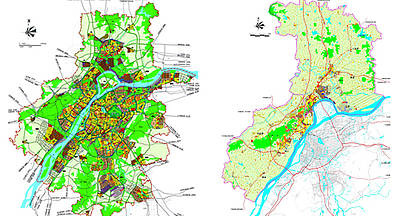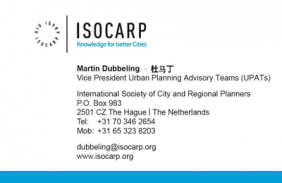ISOCARP has selected a strong Urban Planning Advisory Team (UPAT) for the Jiangbei New Area, Nanjing (PRC).
After an unusually short and very intensive period of preparation, ISOCARP has selected a strong Urban Planning Advisory Team (UPAT) for the Jiangbei New Area, Nanjing (PRC). Dhiru Thadani (India/USA) is appointed as Team Leader. Dr. Awais Piracha (Australia) is appointed as UPAT Rapporteur. Dr. Tomasz Madja (Poland), Dr. Liang Huew Wang (Hong Kong/Malaysia) and Mr. Jos Verweij (the Netherlands) were selected to participate in the first of two UPAT workshops. The first Nanjing UPAT Workshop will be held 11-17 August 2013.
Background and general objectives
In the coming decade, the Jiangbei New Area is an important development area for both the City of Nanjing and the South Jiangsu Region. Jiangbei New Area, north of the Yangtze River, covers an area of 2.450 sq.km. In the near future, this area will have residential areas for 4 million inhabitants, a CBD and districts for factories and industries. The City of Nanjing has the task to transform the Jiangbei New Area into a strategic demonstration zone for (inter) regional and economical development.
The development of the Jiangbei New Area will bring enormous opportunities and challenges for the Yangtze River delta area and the Nanjing Metropolitan area. The City of Nanjing underlines the need for innovative strategies on transit-oriented development and ecological, sustainable and low-carbon urban development. Integrated urban design and landscape design will be needed or the most important nodes and areas of the Jiangbei New Area.
OBJECTIVES OF THE NANJING UPAT
FOUR RESEARCH OBJECTIVES
PLANNING
In September 2013, the international Urban Planning Advisory Team will travel to Nanjing for the second five-day workshop. This workshop will focus on practical visions, designs and implementing tools and steps for a comprehensive development strategy and an integrated spatial plan for the Jiangbei New Area. The results of this second UPAT Workshop will be presented and highlighted in a second UPAT Report with observations, opinions and recommendations on the final day of this UPAT Workshop.
In November 2013, the international Urban Planning Advisory Team International consultant team will travel to Nanjing for a three-day conference. As part of this conference, the UPAT Team will present and highlight their observations, opinions and recommendations in a third UPAT Report. The final UPAT Report needs to be completed within two weeks after this conference.
TEAM ORGANIZATION AND SELECTION
The UPAT Team comprises a total of five to six ISOCARP members. The Team Leader, the UPAT Rapporteur, two to three senior planners and the Vice President UPATs.
The relevant expertise and experience of ISOCARP members for this Project need to match with the scale and complexity of the planning of the Jiangbei New Area and with large scale and metropolitan developments across and along a major river.
The Vice President UPATs sends out the Call for Candidates on 08 July 2013 for a Team Leader, a UPAT Rapporteur and the senior planners. The deadline for the reception of applications is 14th of July 2013. Candidates with the following expertise and skills are encouraged to apply:
- Research of urban industries and economical development;
- Research of sustainable, ecological and low-carbon urban development;
- Research of urban transportation and transit-oriented development;
- Strategic urban planning and urban design;
- Research and analyses of cities, global trends, case studies of best and worst practises;
- The theory and practice of water management in the catchment areas of major rivers;
- Research and review of spatial planning policy documents;
- Writing clear and comprehensive spatial vision and economic documents, translation vision documents into principles, scenarios, strategies and direct applicable practical solutions;
- Working experience in China and Chinese cities is recommended.
The Vice President UPATs has consulted the Nanjing Urban Planning Bureau during a preparatory visit on 10-12 June 2013. During this visit the Scope of Work, the assignment, the objectives, the tasks and the planning of the UPAT Workshop were discussed and prepared.
Next to ISOCARP, the Urban Planning Society of China (UPSC) is also involved as a consultant in this project. ISOCARP and UPSC will jointly take part in every workshop mentioned in this Agreement and in the Scope of Work.
The Vice President UPATs will communicate openly and transparently to all applicants in respect of their considerations in choosing and selecting the UPAT Team.
ASSIGNMENT AND DELIVERABLES
The UPAT is an ISOCARP response to an initiative of the Nanjing Urban Planning Bureau. The Nanjing Urban Planning Bureau will provide all necessary and relevant information, data and maps covering the scope of work of the UPAT Team.
The selected team members will be requested to arrive for the first UPAT Workshop in Nanjing on Saturday 10 August or Sunday morning 11 August 2013 at the latest. The UPAT Workshop starts on Sunday afternoon 11 August with a city tour. The UPAT Team visits the City of Nanjing and the Jiangbei Area, meet representatives and officials of the Nanjing Urban Planning Bureau and will be able to exchange questions and ideas with them during the week. The UPAT Workshop ends with a presentation of the preliminary results on Friday 16 August 2013. The selected team members are free to depart from Nanjing on Saturday 17 August 2013.
The selected team members will be invited to participate in a second UPAT Workshop in September 2013. The specific dates will be discussed later in the process.
The Team Leader and the UPAT Rapporteur will write and illustrate the UPAT Reports with contributions of the UPAT Team members and in consultation with the Vice President UPATs. The UPAT Reports will be discussed during a Technical Seminar at the 49th ISOCARP Congress 1-4 October 2013 in Brisbane and will be presented at an International Conference in Nanjing end of November 2013.
The UPAT Team will bear in mind that both the City of Nanjing and ISOCARP endorse the Report. Hence the Society’s standards of quality and excellence together with the final quality that the Nanjing Urban Planning Bureau would expect to see in such a professional document will be the determinants. The UPAT Report should comprise of all UPAT working documents and materials produced by team members and should be written in fully edited English language.
More information on logistics and how to apply in the members’ area.

